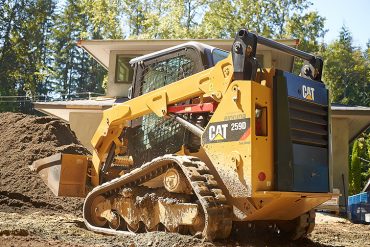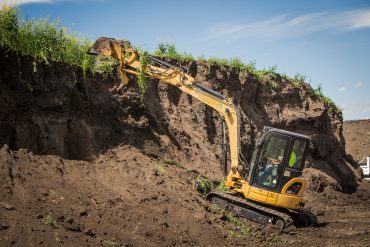
John Bleasby
Realizing the big potential of compact earth moving equipment
Canadian ContractorCompact equipment is a great business add-on, but safety and training are crucial
Compact equipment is everywhere. You’d be hard pressed to find a job site – from the largest most complex project to small residential landscaping jobs – without seeing a skid steer or mini excavator on site at one time or another. Compact equipment is just that — small enough to operate in confined spaces and offering operators the flexibility to easily manoeuvre on tight job sites. Versatility is why compact equipment is used on most job sites but typically underestimated in terms of technology that has improved ease of use, customization and safety.
Technological advancements and the improved versatility of today’s compact equipment helps contractors of all sizes improve productivity and lower costs across the work site. However, training, safety, and proper operation of compact equipment is crucial to operating a safe and productive site. After all, these machines may be small, but they are mighty!
Canadian Contractor talked with Doug Levoguer, Industry Business Manager, Business Construction Products for Finning Canada. Levoguer works as a liaison between dealers and manufacturers to provide insights into compact equipment products to help meet the customer’s needs.
Why are we seeing an increase in the use of this type of equipment?
There are a couple factors contributing to growth in the compact equipment market. First, the construction industry is evolving. We’re seeing more and more urbanization, which means doing more within smaller spaces. And secondly, the equipment is getting better. These machines are smaller in size, but we can get more out of them than ever before. We’re essentially giving small machines the same attributes as their larger counterparts. And when you add attachments — which today are smarter, faster and easier to use — you can turn a simple mini-excavator into a machine with endless options.
When it comes to the safe operation of compact earth-moving equipment, why is it so important for contractors to ensure its proper use?
Given the features and adaptability of today’s smaller equipment, we’re seeing increased use by less experienced operators. And while new technologies can make operators with fewer skills better, training and knowledge still remain the most important elements for the safe and efficient operation of equipment.
 What are the key aspects of site safety when it comes to operating these machines?
What are the key aspects of site safety when it comes to operating these machines?
Operators should always be aware of their surroundings. On-board cameras give the operator greater visibility of the job site and help identify any safety hazards. Today’s machines are equipped with both back-up cameras and 360 degree cameras. Proximity sensors and alarms help to notify the operator or other workers when there may be an issue. Further, electronic fencing features allow operators to upload on-site parameters to limit the reach of an excavator to ensure it does not come into contact with power lines, for instance. These same machines have the ability to electronically limit dig depth and assist operator inputs in a balance between safety and productivity. Awareness of your surroundings and machine capacity is also key — operators need to be aware of the machine’s dimensions for turns, and for operating within the working space.
Is there a risk of smaller equipment being used, let us say, somewhat casually?
It’s really important to take the operation of compact equipment as seriously as you would larger heavy equipment. Recent technological advancements may mean easier operation of compact equipment, but that doesn’t mean technology can replace training. Educating operators is the first step towards ensuring everyone stays safe on the jobsite, while also maintaining efficiency and productivity.
What are some basic safety processes — for example as part of the start-up routine?
There are some standard operating techniques every operator should follow. Never skip the inspection. Operators should always do a walk-around before they operate the equipment, and once again when they finish the job, to check for leaks and other general maintenance issues. If left unnoticed, these can result in unsafe operation. This also minimizes wear and tear and is key to keeping maintenance costs down. Following regular maintenance schedules will extend the life of your machine and keep it operating to the best of its capability.
 What is your best advice to operators to get the most out of their machine?
What is your best advice to operators to get the most out of their machine?
Making it work for you to the best of its ability to maximize uptime is key. One of the best things you can do is to educate yourself on the equipment – this includes everything from reading the manual to training courses. This will help you get the most of out of your machine and will answer many of your questions right from the start. Manufacturers put a great deal of time and resources into manuals to provide all the information you may need, and the right dealer can provide additional support through the life of your machine.
The other element is understanding the technology. Knowing the settings on a machine and that they can be adjusted to meet your needs and the skill level of your operator, can optimize your performance on any job site. Certain wheel loaders with hydrostatic transmissions and industry leading software are able to adjust to the operator’s preferred type of control. With the push of a button the operator can adjust the machine response to increase the tractive efforts on ice, or mimic the neutral roll out of a traditional torque converter machine, or maintain the characteristics of a hydrostatic machine.
Can you discuss the importance of understanding a machine’s lift capacity? What should operators do before they start lifting loads with their equipment?
This again all comes down to training and operator knowledge. First, know the parameters of the machine. This includes percentage of tipping load, the range of the machine, and the angle of the ground on which you are operating. Consider ahead of time what you are doing with the machine, and then demo the equipment in the context of that application. There are lifting charts available for most equipment to help, and some machines are equipped with alarms and notifications to alert the operator when approaching tipping capacity.
There’s lots of talk about fuel consumption and the environment. What’s your advice for owners/operators wanting to maximize the fuel efficiency of their equipment?
First, consider the age of the machine you are operating — newer equipment from premium brands deliver much better fuel efficiency. Throttle management is also key. It’s common place for operators to run full throttle day in & day out, but there is much to gain by using the foot throttle in a skid steer, for instance. Today’s new technology means better fuel efficiency, less emissions, and more effective equipment that doesn’t need to operate all out, all day.
What is the main tip you would offer to promote the safe operation of compact equipment?
My biggest tip is to never get too comfortable or complacent in the drivers seat, and minimize distractions when you are operating equipment. Even though these are smaller machines, they are still incredibly powerful. We often see a hierarchy associated with the size of machine and skill of the operator. However, compact equipment reacts in the same way as the big machines, and should therefore be treated and respected in the same way.

Leave a Reply